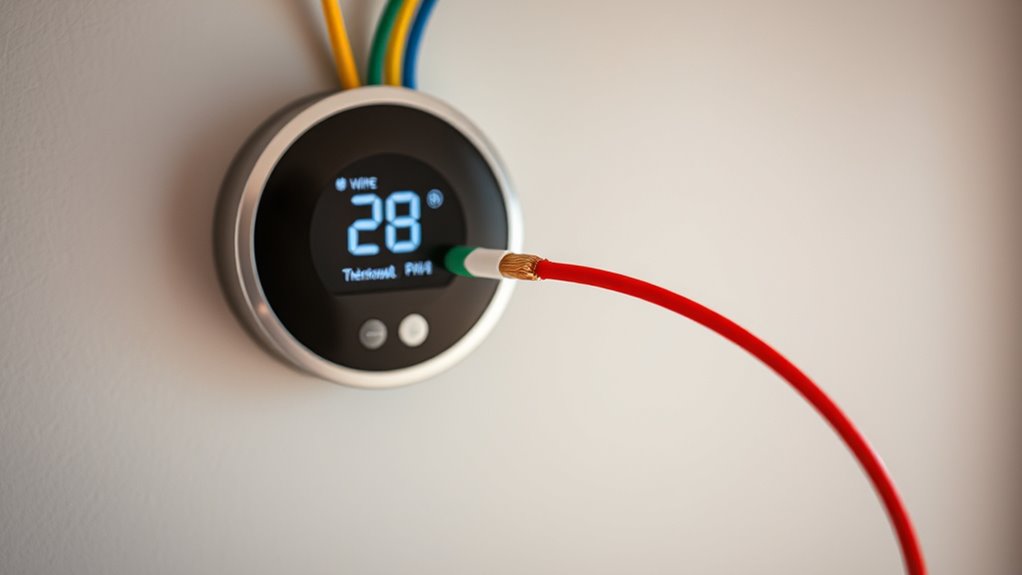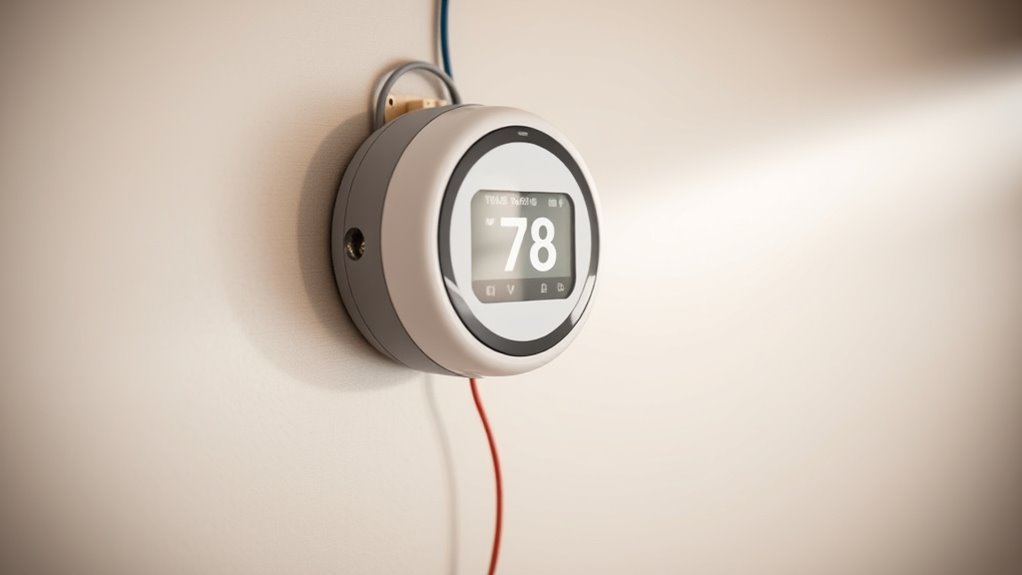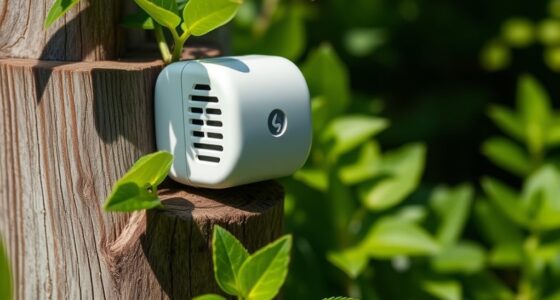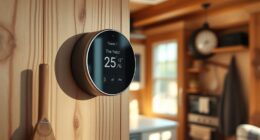If your thermostat lacks a C-wire, you can still install it by using smart power options like a power extender kit, re-routing existing wires such as moving G to C, or installing a separate transformer to supply continuous power. Some smart thermostats come with built-in power solutions that eliminate the need for a dedicated wire. For detailed tips and step-by-step guides, keep exploring ways to make your setup work seamlessly without a common wire.
Key Takeaways
- Use a Power Extender Kit (PEK) to provide continuous power without needing a C-wire.
- Rewire existing wires by connecting the G wire to the C terminal, ensuring proper voltage and safety.
- Install a dedicated transformer to generate a stable C-wire signal for your thermostat.
- Utilize smart thermostats with built-in power modules that operate without a C-wire.
- Use a dummy C-wire adapter or bypass kit to simulate a common wire connection for compatibility.
Understanding the Role of the C-Wire in Thermostat Installation

The C-wire, or common wire, plays a crucial role in thermostat installation by providing a continuous flow of power to your device. Without it, your thermostat may not receive reliable power, especially for smart models with advanced features. To guarantee proper operation, you need to check thermostat compatibility, as some older models don’t require a C-wire. When wiring your thermostat, pay close attention to wiring color codes—typically, the C-wire is blue, but it can vary. Correctly identifying and connecting this wire ensures your thermostat functions properly and avoids issues like power loss or system malfunctions. Understanding the role of the C-wire helps you troubleshoot compatibility and wiring concerns, making installation smoother and more reliable. Additionally, staying informed about AI security developments can help you better protect your smart home systems from vulnerabilities.
Identifying Alternative Power Sources in Your HVAC System

You can often find alternative power sources in your HVAC system by spotting auxiliary power lines or wires. Sometimes, existing components like the transformer or other control wires supply the power needed for your thermostat. Identifying these options can help you set up reliable power without a dedicated C-wire. Additionally, understanding power management within your system can reveal hidden sources of energy that are suitable for powering your thermostat. For example, some systems utilize shared wiring with other components, which may provide the necessary power for operation. Recognizing energy efficiency ratings can also guide you in choosing the most suitable alternative power source for your setup.
Detecting Auxiliary Power Lines
Are you wondering how to identify if your HVAC system has an auxiliary power line or alternative power source? Start by inspecting the wiring at your furnace or air handler. Look for wire color codes—red, yellow, or blue wires often indicate auxiliary or secondary power lines. To confirm, perform voltage testing with a multimeter. Turn off power, then carefully test between the suspect wire and a ground—if you see around 24 volts, you’re likely dealing with an auxiliary power source. Be cautious during testing to avoid shorts or shocks. This process helps you determine if your system supplies power independently of the C-wire. Recognizing these wires ensures you understand your system’s wiring setup, which is vital before attempting any modifications or installations. Additionally, understanding electrical wiring conventions can help you interpret your system’s wiring more effectively. Knowing how to identify these wires also aids in troubleshooting and ensuring safe, proper connections when installing smart thermostats or other compatible devices. Familiarity with power source types can further improve your diagnosis and installation process.
Utilizing Existing HVAC Components
Once you’ve identified the auxiliary power lines, exploring how existing HVAC components can supply power becomes important. Many wireless thermostats are designed for HVAC compatibility, allowing them to draw power directly from the system’s wiring. Check if your furnace or air handler has terminals labeled for auxiliary or common (C-wire) connections. Some systems can provide power through the R and G wires, or via other control wires that carry voltage during operation. If your HVAC system supports it, you might be able to repurpose existing components, such as the transformer, to power your thermostat. Always verify your system’s wiring and specifications to confirm compatibility. Understanding HVAC wiring systems can help you identify the best power source for your thermostat. Properly assessing your system’s electrical configuration can prevent potential power issues and ensure reliable operation. Using existing HVAC components can simplify installation and eliminate the need for additional power sources.
Using a Power Extender Kit (PEK) to Provide Continuous Power

A Power Extender Kit (PEK) offers a practical solution for ensuring your smart thermostat always has continuous power, especially when the existing wiring falls short. With a PEK, you can keep your digital thermostats running smoothly and your wireless sensors connected without interruption. Imagine never worrying about power loss during critical moments or missing updates from your sensors. Moreover, using a PEK can help prevent system malfunctions caused by inadequate wiring. A PEK simplifies installation, making it easier to upgrade your setup and maintain perfect climate control effortlessly. Additionally, employing a PEK can extend the lifespan of your thermostat and related components by reducing power surges and fluctuations that may occur with unreliable wiring. As industry experts increasingly focus on AI-driven solutions in healthcare and other fields, adopting reliable hardware like a PEK becomes even more essential.
Reallocating Wires for a Functional Power Setup

Reallocating wires can often solve power issues by guaranteeing the correct connections are in place for your thermostat to receive reliable power. Wire reallocation involves moving existing wires to different terminals, redirecting power where it’s needed most. This process effectively handles power rerouting, especially when the original wiring setup doesn’t support a C-wire. Carefully identify the wires connected to your existing terminals, then switch them to appropriate locations, such as moving a wire from the G terminal to the C terminal if available. Proper wire reallocation ensures your thermostat gets continuous power without installing additional hardware. Additionally, understanding the self watering plant pots can help clarify the type of components involved in your setup, ensuring compatibility and safety. Take caution to avoid short circuits or incorrect connections. When done correctly, this method restores consistent power and improves thermostat performance without major rewiring or costly upgrades.
Employing a Transformer to Generate the C-Wire Signal

When rewiring isn’t enough to provide a reliable C-wire, adding a dedicated transformer can supply the necessary power. Transformer installation allows you to generate a stable power signal, ensuring your thermostat functions correctly. This method gives you confidence, knowing your system won’t lose power unexpectedly. Additionally, using a transformer can help prevent issues related to digital literacy programs, which encourage playful communication and increased smartphone usage among seniors. Incorporating automation technologies into your systems can further enhance reliability and simplify maintenance.
Utilizing a Smart Thermostat With Built-In Power Options

Using a smart thermostat with built-in power options can eliminate the need for complex wiring or additional components. These thermostats often feature wireless control, allowing you to manage your HVAC system remotely without relying solely on wired connections. Many models are battery powered, which means they don’t need a constant power source from the C-wire. Instead, they draw power from batteries, simplifying installation in homes without a common wire. This setup is ideal if you want a clean, straightforward solution that avoids rewiring or adapters. Additionally, efficient general ledger coding can support better financial management, even for small home projects. Many of these thermostats also incorporate wireless communication protocols like Wi-Fi or Zigbee, enhancing their connectivity and functionality. Keep in mind, however, that battery-powered thermostats require occasional battery replacements, but they still provide reliable operation and smart features like scheduling and energy monitoring. Utilizing battery-based power solutions can further streamline installation and reduce wiring complexity, making these thermostats a popular choice for many homeowners. This approach offers a convenient alternative for modern comfort and control.
Installing a Bypass or Dummy C-Wire Adapter

Installing a bypass or dummy C-wire adapter provides a simple solution for homes without a common wire, allowing your smart thermostat to function reliably. This device tricks your thermostat into thinking it has a C-wire, ensuring consistent power from alternative sources. It’s a quick, cost-effective fix that keeps your wireless thermostats running smoothly without rewiring. Additionally, embracing organization and regular maintenance can prevent clutter and ensure your HVAC system operates efficiently. Properly managing system components can further enhance performance and lifespan of your setup, and incorporating practices like regular cleaning of your thermostat and wiring can help maintain optimal operation.
Tips for Ensuring Safe and Reliable Wiring Modifications

Before making any wiring changes, guarantee the power is turned off to prevent shocks or damage. Use the correct wiring tools to make secure and precise connections. Taking these precautions helps keep your modifications safe and reliable. Additionally, choosing a preppy dog name that suits your pet’s personality can add a touch of style to your everyday routine. Understanding essential oils for safety and proper application can further ensure a safe environment during your DIY projects. Being aware of juice recipes and mixes can inspire creative ideas for home projects, even those unrelated to wiring.
Verify Power Off Properly
Are you confident the power is truly off before working on your wiring? Verifying no electrical current is flowing is essential for safety and accurate sensor calibration. Follow these steps to verify power off properly:
- Use a reliable voltage tester or multimeter to double-check the wires—don’t rely solely on the switch.
- Turn off the circuit breaker and wait a few minutes to allow any residual power to dissipate.
- Confirm the power is off before touching the thermostat wiring, especially if you’re adjusting for a C-wire or modifying the wiring for thermostat programming.
Taking these precautions prevents shock and ensures your modifications won’t interfere with sensor calibration or thermostat operation later. Proper verification keeps your work safe and reliable.
Use Correct Wiring Tools
Using the correct wiring tools is essential to guarantee your modifications are safe and reliable. Proper tools prevent damage and ensure secure connections. Always choose a wire stripper that matches the wire gauge to avoid nicking or weakening the wire. A multimeter helps verify power is off before working. Use tools with clear insulation to prevent accidental shorts. Pay attention to color coding, which indicates wire purpose, ensuring correct connections.
| Tool | Purpose | Tip |
|---|---|---|
| Wire stripper | Remove insulation precisely | Match to wire gauge for clean removal |
| Multimeter | Check voltage and continuity | Confirm power is off before touching wires |
| Screwdriver | Tighten or loosen terminal screws | Use insulated handles for safety |
| Pliers | Bending or gripping wires | Use needle-nose for precision |
Frequently Asked Questions
Can I Install a Thermostat Without Any Wires at All?
You can install a thermostat without any wires at all by opting for wireless thermostats. These units often use Wi-Fi or Bluetooth to connect to your HVAC system, eliminating the need for traditional wiring. Some models include a power extender or require batteries for power. Just guarantee your wireless thermostat is compatible with your system and that you follow installation instructions carefully to avoid issues.
Are There Compatibility Issues With Different HVAC Systems and C-Wire Alternatives?
Ever think your smart thermostat will just work everywhere? Think again. Compatibility concerns with C-wire alternatives vary widely across HVAC system types. Some systems need a traditional C-wire, while others can handle power through innovative methods. You might find yourself fighting compatibility issues or risking system damage if you don’t match your system’s needs. Always check your HVAC system’s specifications before attempting to install a C-wire alternative—otherwise, you could end up in a wiring nightmare.
How Do I Know if My Existing Wiring Setup Supports a Power Extender Kit?
To determine if your wiring supports a power extender kit, start by inspecting your wiring setup. Check the wire gauge; it should be compatible with the kit’s requirements, usually 18-22 gauge. Confirm the circuit breaker isn’t overloaded, as a proper breaker protects the system. If your wires are in good condition, properly rated, and your breaker can handle the additional load, your setup likely supports a power extender kit.
What Are the Safety Risks Involved in Modifying My Thermostat Wiring?
Ever wondered about the safety risks of modifying your thermostat wiring? You should know that improper wiring can lead to electrical shock or fire hazards. If you’re not experienced with electrical work, you risk damaging components or creating dangerous situations. Always turn off power before working on your thermostat, and consider consulting a professional to avoid potential hazards. Would you rather risk safety or ensure proper, secure wiring?
Will Using a Dummy C-Wire Affect My Thermostat’s Performance or Warranty?
Using a dummy C-wire may impact your thermostat’s performance and warranty because it can cause wireless power issues, leading to inconsistent operation. Compatibility concerns arise if your thermostat isn’t designed to work with a dummy wire, potentially voiding your warranty. Always check your thermostat’s specifications and consult the manufacturer before using a dummy C-wire, as it might not provide reliable power or support all features properly.
Conclusion
Did you know nearly 70% of homes lack a dedicated C-wire for thermostats? Luckily, you can still upgrade your system without it. By exploring options like power extender kits or smart thermostats with built-in power, you can keep your HVAC running smoothly. Just remember to prioritize safety and proper wiring. With these hacks, you’ll enjoy a seamless upgrade without the need for complex rewiring—making your smart home more efficient and comfortable.









